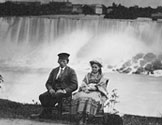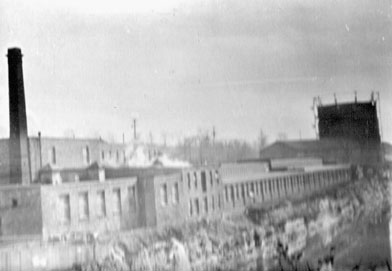

|
||||||||||||||||||||||||||||||||||||||||||
|
| ||||||||||||||||||||||||||||||||||||||||||
 |
 |
 |
 |
 Niagara Textile  Many who are alive today remember the spectacular fire on Sunday night, April 11, 1965. The roaring blaze completely gutted the remains of a once thriving Lockport business. The Niagara Textile Company, just south of today’s Tri-Way Bridge below Garlock’s Restaurant, was housed in an 80,000 square foot stone and brick edifice. At the turn of the century, the Erie Canal provided for the low cost of power and ease of transportation, and as a result, four textile plants grew and thrived in Lockport: Niagara Textile, Lockport Textile, Lockport Linen Mills and Empire Manufacturing. The Niagara Textile Company survived the longest and was famous worldwide for its assortment of towels and linens, and was perhaps most well known for its towels that incorporated a view of Niagara Falls into the weave. The prime mover and shaker at the company’s inception was Willard Tarbell Ransom, a director of Lockport Savings Bank, who had experience as a dry-goods merchant in the city near the end of the 19th century. He admired the many towels and textile goods that were being imported from Scotland and Ireland and he conceived the plan to produce these items locally. As a result, Mr. Ransom formed the Niagara Textile Company with at least eight other investors that provided capital of about $3,000. They purchased the machinery from a textile mill in Philadelphia and moved the equipment into a small stone building located at the corner of Transit St. and State Street on the Erie Canal. The company flourished while under contract to provide towels for the new Pullman Company that produced sleeper-cars for the burgeoning railroad industry. Before awarding Niagara Textile this contract, Pullman had purchased his “huck” towels in Scotland. The towels for Pullman were woven with a one-inch blue stripe with Pullman’s name through the center lengthwise. Niagara Textile became the sole provider of towels for Pullman through the end of WWI. The strength of their largest customer helped them to grow their business into a huge 80,000 square-foot manufacturing and distribution complex. The impressive structure was L-shaped and about 350-feet long and 125-feet wide, and the foundation and walls were built upon the same solid rock that made construction of the Erie Canal so difficult. At its peak in the 1930s, the company produced over 8 million square yards of woven linen each year. Douglas Farley, Director Ann Marie Linnabery Erie Canal Discover Center 24 Church St. Lockport NY 14094 716.439.0431 CanalDiscovery@aol.com www.NiagaraHistory.org |
|